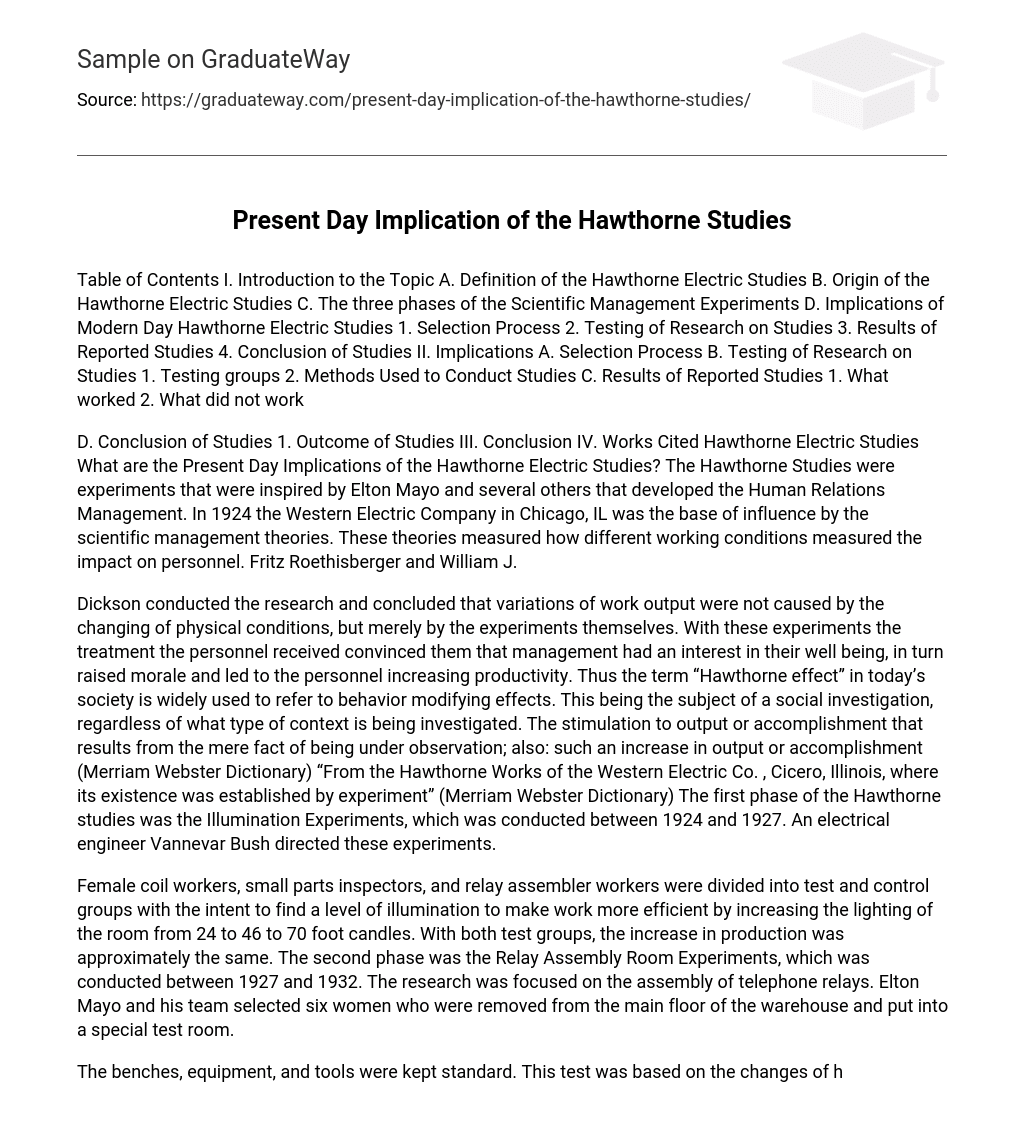The Hawthorne Studies were experiments that were inspired by Elton Mayo and others who developed Human Relations Management. In 1924, the Western Electric Company in Chicago, IL served as the foundation for scientific management theories, which measured the impact of various working conditions on personnel.
According to Fritz Roethisberger and William J. Dickson, their research findings showed that the differences in work output were not due to changes in physical conditions, but were instead a result of the experiments themselves. The treatment received by the personnel during the experiments made them believe that management cared about their well-being, which in turn boosted morale and increased productivity. As a result, the term “Hawthorne effect” is commonly used in society today to describe the behavior-modifying effects observed in social investigations, regardless of the specific context being investigated.
The Hawthorne studies, conducted between 1924 and 1927 at the Hawthorne Works of the Western Electric Co. in Cicero, Illinois, established the concept of the Hawthorne effect. According to the Merriam Webster Dictionary, the Hawthorne effect refers to the increase in output or accomplishment that occurs simply from being under observation. The initial phase of these studies, known as the Illumination Experiments, was directed by electrical engineer Vannevar Bush.
Female coil workers, small parts inspectors, and relay assembler workers were divided into test and control groups. The aim was to determine the optimal level of illumination for improving work efficiency by increasing the room’s lighting from 24 to 46 to 70 foot candles. Both test groups showed similar increases in production.
The second phase of the research was the Relay Assembly Room Experiments, which took place from 1927 to 1932. This stage focused on assembling telephone relays. Elton Mayo and his team handpicked six women to be relocated from the main warehouse floor to a dedicated test room.
The test was conducted in a controlled environment, where the benches, equipment, and tools remained standard. The study focused on analyzing the impact of changes in hours worked and rest periods given. Furthermore, they monitored the lighting conditions, temperature, and humidity levels in the room. An observer was present throughout the entire test period to document all events that occurred in the room with the women. Despite the absence of a supervisor, the women took responsibility for their actions and collaborated on making decisions regarding work modifications. The working environment underwent 23 experiments, which involved implementing rest breaks at different times and durations, shorter workdays, and having Saturdays off.
The output increased, and only dropped slightly even after the conditions returned to what they were before the test began. The third phase was the Bank Wiring Observation Room Experiment, which was conducted between 1931 and 1932. This test involved 11 men whose job was to assemble terminal banks used in telephone exchanges. The men established their own standard of how they wanted a fair day’s work. They did not trust the goals of the project and restricted production. Despite the pay scale they were given, they mocked and ill-treated anyone who tried to work faster or slower than what they considered the norm.
After conducting all experiments, the study revealed that workers did not react positively to the conventional motivational methods proposed in Frederick W. Taylor’s Scientific Management theory. The most significant finding was that workers had a compelling need to communicate and collaborate with their peers. According to Frederick W. Taylor’s theory, workers are exclusively driven by self-interest. Theorists have presupposed that workers only strive to fulfill their work responsibilities with minimal effort in order to increase their monetary rewards.
The Hawthorne studies resulted in a more trusting and team-focused work environment. It is believed that 50 percent of the success of a training session can be attributed to the Hawthorne Effect. The significance of previous investigations using the Hawthorne Effect was to improve performance by measuring and making participants aware of the outcomes.
Therefore, it is suggested that the Hawthorne effect may only have a substantial influence when there is a perceived need for performance improvement. However, certain studies have discovered that the behavior of participants can be altered if the investigators express interest in the anticipated outcome. However, no research on the Hawthorne effect has investigated whether participants in non-interventional observation studies, who were not explicitly informed about the outcome, modify their behavior during the observation period.





